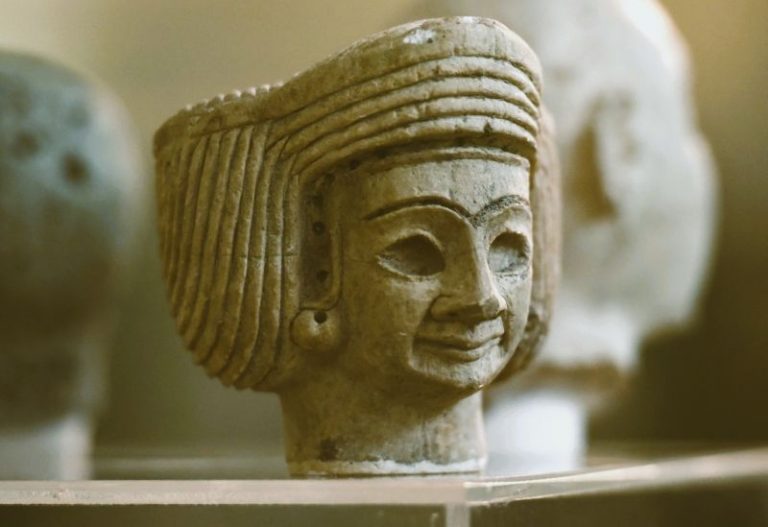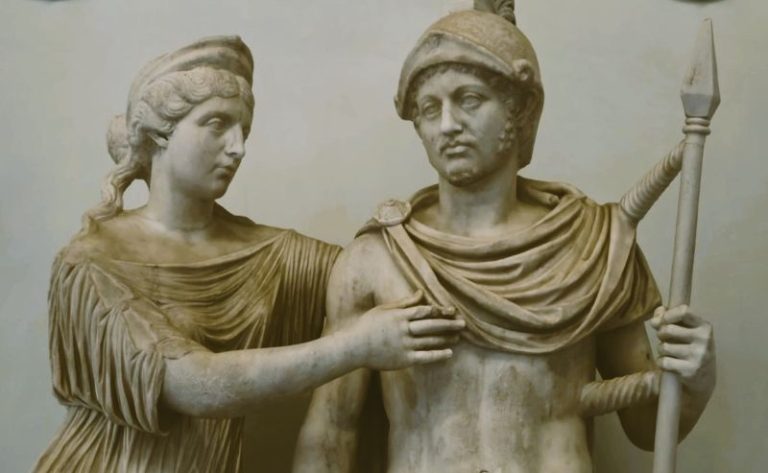
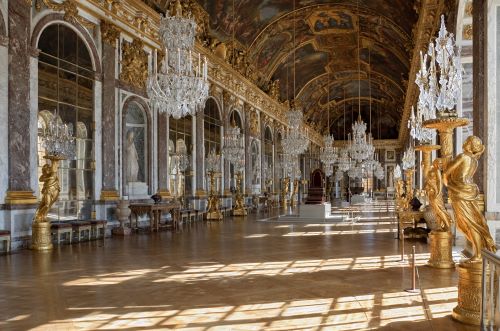
If it now serves as a monument more than a mandate, it is because it accomplished what it set out to do. Versailles wrote monarchy into myth, and myths, however dethroned, do not die easily.

By Matthew A. McIntosh
Public Historian
Brewminate
A Dream Carved from Mud: Foundations of Versailles
When Louis XIV transformed his father’s modest hunting lodge into one of the most extravagant architectural feats of European history, he was not merely building a palace; he was drafting an ideology into stone and spectacle. The Palace of Versailles emerged in the late seventeenth century as both a practical seat of governance and a metaphysical stage for the performance of absolutism. It was a court without rival, set apart geographically and symbolically from the tumultuous Parisian masses, asserting itself as the axis around which all of France must revolve.
The original lodge, constructed by Louis XIII in 1623, lay in the marshy outskirts of Paris, an unlikely site for imperial grandeur. Yet it was precisely this location, a tabula rasa of sorts, that appealed to Louis XIV. The choice to build a palace far from the traditional centers of power was neither accidental nor whimsical. It was a spatial gesture of sovereignty, allowing the king to physically and psychologically distance the court from Paris, which had so recently been a site of rebellion during the Fronde.1
Louis began expanding the estate in 1661, shortly after the death of his chief minister, Cardinal Mazarin. With Mazarin gone, the young king resolved to rule personally, no longer mediated by the clerical hand of statecraft. Versailles thus became the material emblem of a monarch who, in his own words, would “govern alone”.2 The process of transforming the modest estate into a palace of unparalleled scale involved thousands of laborers and artisans over multiple decades. Architects like Louis Le Vau and Jules Hardouin-Mansart, along with the painter Charles Le Brun and landscape designer André Le Nôtre, were enlisted in the creation of what became a theatrical synthesis of architecture, art, and political philosophy.3
Stones That Speak: Architectural Language of Control
From its inception, Versailles was designed not simply to house the monarch, but to shape the very perception of monarchy. Every brick, column, and corridor communicated hierarchy and control. The grand axis of the palace, stretching out into meticulously symmetrical gardens, conveyed cosmic order, with the king, like the sun, anchoring the celestial arrangement.
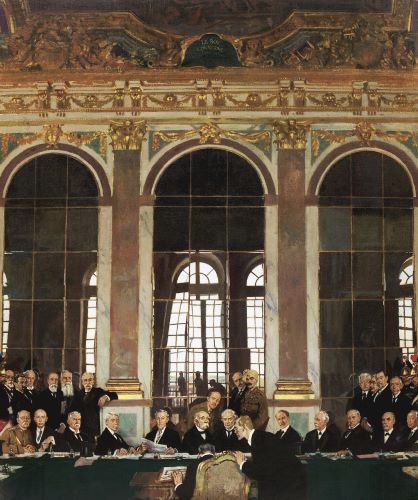
The most celebrated room in Versailles, the Hall of Mirrors (Galerie des Glaces), completed in 1684, is not merely a feat of reflective spectacle. It serves as an architectural metaphor for surveillance and self-regard. Courtiers, continually observed and reflected back upon themselves, were trapped in an environment that policed decorum as much as it celebrated grandeur.4 The mirrors were also an assertion of French craftsmanship over Venetian dominance in glass production, a subtle but potent assertion of cultural self-sufficiency.5
Yet the layout of the palace itself played a more intimate role in reinforcing absolutism. The king’s bedchamber was the symbolic heart of the structure, and it was from this room that the day’s elaborate rituals unfolded: the lever (rising), the coucher (retiring), and the many staged movements in between that placed the monarch in continuous performance before his courtiers.6 These rituals were not merely theatrical embellishments but functional instruments of control, reducing the nobility to the role of attendants, their ambitions dissolved into the minutiae of etiquette.
Gardens of Allegory: Nature Tamed and Ordered
Versailles was not confined to stone. Its gardens, stretching endlessly into the horizon, were a philosophical argument rendered in hedgerows and fountains. Designed by Le Nôtre, the landscape became a stage of visual allegory, where mythological sculptures and hydraulic marvels functioned as narratives of domination, not only over nature but over the unruly human elements the monarch claimed to discipline.
The gardens’ geometric precision, their taming of the natural into the rational, echoed the broader project of the Enlightenment even before its formal emergence. At Versailles, nature was not something to be revered for its wild beauty, but to be ordered, disciplined, and put to aesthetic and political use. The fountains, most notably those depicting Apollo, Louis XIV’s chosen emblem, underscored the king’s solar identity, linking him to divine constancy and illumination.7
Water itself became a source of symbolism and strain. The complex hydraulic system required to power the hundreds of fountains necessitated the construction of the Machine de Marly, one of the most ambitious engineering projects of the era.8 In this way, even infrastructure became a statement: the king could command not only men, but elements.
Versailles as a Court: Politics of Presence and Absence
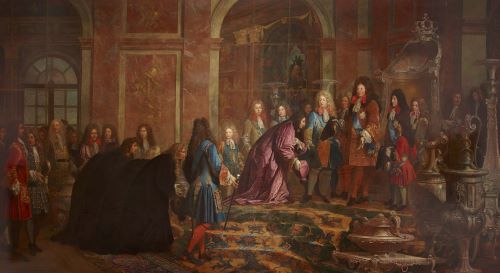
More than a royal residence, Versailles became the locus of French political life. In 1682, Louis officially moved his court there, and by doing so, rewrote the rules of governance. Ministers, nobles, and ambassadors all had to maintain a presence at court, where visibility was synonymous with power. Yet access was always mediated, never fully guaranteed. The king’s favor became the coin of the realm, distributed not through policy but proximity.
By compelling the nobility to live under his watchful eye, Louis weakened their provincial bases of power and transformed them into decorative functionaries. Dressed in velvet and constrained by protocol, they were ornaments of the regime rather than threats to it. This model of rule by performance prefigured what modern sociologists would later theorize as symbolic power, the capacity to rule not just by law, but by the control of meanings.9
However, the very theatricality that made Versailles so effective in projecting monarchical strength would, over time, reveal its fragility. The enormous costs of maintenance, the alienation of a Parisian populace left to hunger while nobility danced in gilded halls, and the increasingly ossified rituals of court life contributed to the perception of a regime detached from reality. By the time of Louis XVI, Versailles had become not a symbol of power, but of excess.10
Revolution and Ruin: Versailles After the Fall
The French Revolution redefined the meanings encoded into Versailles. No longer a theater of power, it became a museum of past mistakes. On October 5, 1789, a crowd of Parisian women marched to Versailles, angry over bread shortages and demanding the king’s return to the capital. Their presence shattered the palace’s aura of inviolability. Louis XVI and Marie Antoinette were escorted to Paris, and the palace was effectively abandoned as a royal residence.
Versailles soon became the subject of debate: should it be destroyed, preserved, or repurposed? Revolutionary governments stripped it of much of its furniture and art, but the structure endured. Under Napoleon and later the restored Bourbons, it shifted roles, from ruin to relic, then to symbol of national continuity. In the nineteenth century, Louis-Philippe converted it into a museum “for all the glories of France,” reflecting the nation’s new identity as a republic that still revered its monarchical past.11
By the twentieth century, Versailles had transitioned again, this time into a global stage. In 1919, the Treaty of Versailles was signed in the Hall of Mirrors, ending World War I and imposing harsh terms on Germany. The irony was palpable. A room built to immortalize the glory of Louis XIV now bore witness to the reshaping of Europe. Versailles remained what it had always been: a place where the world watched history perform itself.
Conclusion: The Echoes of Stone
Versailles endures because it was never merely a building. It was an idea carved into material, a philosophy of governance, a theology of monarchy, and an aesthetic of domination. Its corridors echo not only with the footsteps of courtiers but with the ideologies they embodied. Today, Versailles remains a mirror not just of the Sun King’s ambition, but of a Europe that once believed power could be made eternal through architecture, etiquette, and spectacle.
If it now serves as a monument more than a mandate, it is because it accomplished what it set out to do. Versailles wrote monarchy into myth, and myths, however dethroned, do not die easily.
Appendix
Footnotes
- Emmanuel Le Roy Ladurie, The Ancien Régime: A History of France 1610–1774 (Oxford: Blackwell, 1996), 204.
- Peter Burke, The Fabrication of Louis XIV (New Haven: Yale University Press, 1994), 25.
- Robert W. Berger, Versailles: The Chateau of Louis XIV (University Park: Pennsylvania State University Press, 1985), 11–14.
- Katie Scott, “The Mirror and Manners: Watching, Being Watched, and Watching Oneself in Rococo Spaces,” Lumen 37 (2018): 101-102.
- Jean-Pierre Babelon, and Constans, Claire. Versailles: Absolutism and Harmony, (Paris: Vendome Press, 1998), 77.
- Norbert Elias, The Court Society, trans. Edmund Jephcott (New York: Pantheon, 1983), 51–60.
- Michel Baridon, A History of the Gardens of Versailles (Philadelphia: University of Pennsylvania Press, 2008), 132.
- Ian Thompson, The Sun King’s Garden: Louis XIV, André Le Nôtre and the Creation of the Gardens of Versailles (New York: Bloomsbury, 2006), 193.
- Clifford Geertz, “Centers, Kings, and Charisma: Reflections on the Symbolics of Power,” in Local Knowledge (New York: Basic Books, 1985), 121–146.
- Simon Schama, Citizens: A Chronicle of the French Revolution (New York: Vintage Books, 1989), 202–203.
- Pégard, Catherine, Versailles: The Great and Hidden Splendours of the Sun King’s Palace (London: Thames Hudson, 2017), 276.
Bibliography
- Babelon, Jean-Pierre and Claire Constans. Versailles: Absolutism and Harmony, (Paris: Vendome Press, 1998).
- Baridon, Michel. A History of the Gardens of Versailles. Philadelphia: University of Pennsylvania Press, 2008.
- Berger, Robert W. Versailles : The Chateau of Louis XIV. University Park: Pennsylvania State University Press, 1985.
- Burke, Peter. The Fabrication of Louis XIV. New Haven: Yale University Press, 1994.
- Elias, Norbert. The Court Society. Translated by Edmund Jephcott. New York: Pantheon, 1983.
- Pégard, Catherine, Versailles: The Great and Hidden Splendours of the Sun King’s Palace, London: Thames Hudson, 2017.
- Geertz, Clifford. “Centers, Kings, and Charisma: Reflections on the Symbolics of Power.” In Local Knowledge, 121–146. New York: Basic Books, 1985.
- Ladurie, Emmanuel Le Roy. The Ancien Régime: A History of France 1610–1774. Oxford: Blackwell, 1996.
- Schama, Simon. Citizens: A Chronicle of the French Revolution. New York: Vintage Books, 1989.
- Scott, Katie. “The Mirror and Manners: Watching, Being Watched, and Watching Oneself in Rococo Spaces.” Lumen 37 (2018): 91-105.
- Thompson, Ian. The Sun King’s Garden: Louis XIV, André Le Nôtre and the Creation of the Gardens of Versailles. New York: Bloomsbury, 2006.
Originally published by Brewminate, 08.05.2025, under the terms of a Creative Commons Attribution-NonCommercial-NoDerivatives 4.0 International license.
